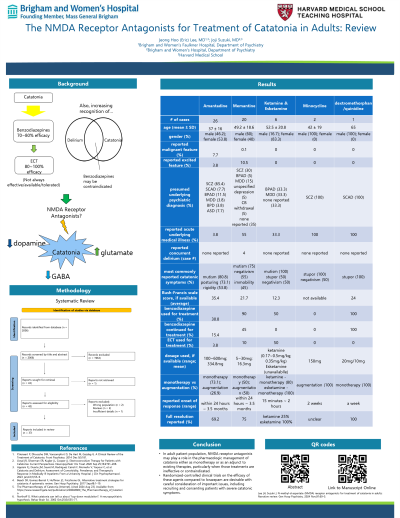Catatonia
(027) N-Methyl-D-Aspartate receptor antagonists for treatment of catatonia: review


Jeong Hoo Lee, MD (he/him/his)
Consultation-Liaison Psychiatrist
Brigham and Women's Faulkner Hospital
Jamaica Plain, Massachusetts
Joji Suzuki, MD
Director, Division of Addiction Psychiatry
Brigham and Women's Hospital
Boston, Massachusetts
Presenting Author(s)
Co-Author(s)
Background: The management of catatonia with benzodiazepines presents a clinical dilemma when delirium co-exists. This review discusses the utility of NMDA receptor antagonists as alternatives to benzodiazepines in the treatment of catatonia without worsening delirium.
Methods: A search of PubMed was conducted in December 2023 for peer-reviewed manuscripts reporting on the use of NMDA receptor antagonists to treat catatonia. References from identified manuscripts were also examined for additional relevant articles.
Results: Thirty-five articles, including case reports, case series, and systematic reviews, were identified. No randomized trials were identified. Amantadine (27 cases in 13 articles) and memantine (13 cases in 11 articles) were the most commonly reported agents. Amantadine, typically used as monotherapy or adjunctive therapy with benzodiazepines, showed quick responses at doses ranging from 100 to 600mg daily. Memantine, used alone or with lorazepam, demonstrated rapid responses at doses of 5 to 20mg daily. A small number of cases (5 cases in 4 articles) reported successful use of ketamine and esketamine, highlighting their potential role in catatonia treatment.
Discussion: NMDA antagonists may be alternative treatments to benzodiazepines in the treatment catatonia, but rigorous research is needed to determine their efficacy and safety in catatonia treatment, especially for newer agents like ketamine and esketamine. Trials comparing these agents to conventional and alternative treatments are also necessary. Despite limitations, NMDA receptor antagonists may be viable options when the patient is partially or not responsive to benzodiazepine treatment, ECT is not available or may not be well tolerating, there is a concern for co-morbid delirium where treatment, or with benzodiazepines or antipsychotics may be contraindicated.
Conclusion: NMDA antagonists may be effective and well tolerated alternative treatment options for catatonia when conventional treatments are ineffective, contraindicated or not available, but further research is needed.
References:
- Appiani FJ, et al. Catatonia and Delirium: Assessment of Comorbidity, Prevalence, and Therapeutic Response in Medically Ill Inpatients From a University Hospital. J Clin Psychopharmacol. 2023 Jan;43(1):55–9.
- Rosebush PI, Mazurek MF. Catatonia and Its Treatment. Schizophr Bull. 2010 Mar 1;36(2):239–42.
- Pandharipande P, Pun BT, Bernard GR. Lorazepam Is an Independent Risk Factor for Transitioning to Delirium in Intensive Care Unit Patients. 2006;104(1).
Presentation Eligibility: I am planning to work on submitting the manuscript for publication on a peer reviewed journal eventually, but it is not likely to be published before November 2024.
Diversity, Equity, and Inclusion: Several studies conducted in Western nations have found that catatonia was more common among individuals from ethnic minorities. This review could be helpful to manage this complex neuropsychiatric syndrome by discussing some of old and potential new NMDAR antagonist agents as the effective alternative treatment options.

